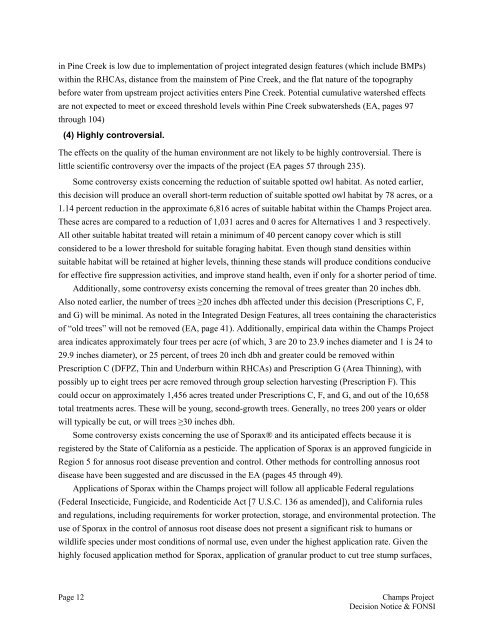Champs Project
Champs Project
Champs Project
You also want an ePaper? Increase the reach of your titles
YUMPU automatically turns print PDFs into web optimized ePapers that Google loves.
in Pine Creek is low due to implementation of project integrated design features (which include BMPs)<br />
within the RHCAs, distance from the mainstem of Pine Creek, and the flat nature of the topography<br />
before water from upstream project activities enters Pine Creek. Potential cumulative watershed effects<br />
are not expected to meet or exceed threshold levels within Pine Creek subwatersheds (EA, pages 97<br />
through 104)<br />
(4) Highly controversial.<br />
The effects on the quality of the human environment are not likely to be highly controversial. There is<br />
little scientific controversy over the impacts of the project (EA pages 57 through 235).<br />
Some controversy exists concerning the reduction of suitable spotted owl habitat. As noted earlier,<br />
this decision will produce an overall short-term reduction of suitable spotted owl habitat by 78 acres, or a<br />
1.14 percent reduction in the approximate 6,816 acres of suitable habitat within the <strong>Champs</strong> <strong>Project</strong> area.<br />
These acres are compared to a reduction of 1,031 acres and 0 acres for Alternatives 1 and 3 respectively.<br />
All other suitable habitat treated will retain a minimum of 40 percent canopy cover which is still<br />
considered to be a lower threshold for suitable foraging habitat. Even though stand densities within<br />
suitable habitat will be retained at higher levels, thinning these stands will produce conditions conducive<br />
for effective fire suppression activities, and improve stand health, even if only for a shorter period of time.<br />
Additionally, some controversy exists concerning the removal of trees greater than 20 inches dbh.<br />
Also noted earlier, the number of trees ≥20 inches dbh affected under this decision (Prescriptions C, F,<br />
and G) will be minimal. As noted in the Integrated Design Features, all trees containing the characteristics<br />
of “old trees” will not be removed (EA, page 41). Additionally, empirical data within the <strong>Champs</strong> <strong>Project</strong><br />
area indicates approximately four trees per acre (of which, 3 are 20 to 23.9 inches diameter and 1 is 24 to<br />
29.9 inches diameter), or 25 percent, of trees 20 inch dbh and greater could be removed within<br />
Prescription C (DFPZ, Thin and Underburn within RHCAs) and Prescription G (Area Thinning), with<br />
possibly up to eight trees per acre removed through group selection harvesting (Prescription F). This<br />
could occur on approximately 1,456 acres treated under Prescriptions C, F, and G, and out of the 10,658<br />
total treatments acres. These will be young, second-growth trees. Generally, no trees 200 years or older<br />
will typically be cut, or will trees ≥30 inches dbh.<br />
Some controversy exists concerning the use of Sporax® and its anticipated effects because it is<br />
registered by the State of California as a pesticide. The application of Sporax is an approved fungicide in<br />
Region 5 for annosus root disease prevention and control. Other methods for controlling annosus root<br />
disease have been suggested and are discussed in the EA (pages 45 through 49).<br />
Applications of Sporax within the <strong>Champs</strong> project will follow all applicable Federal regulations<br />
(Federal Insecticide, Fungicide, and Rodenticide Act [7 U.S.C. 136 as amended]), and California rules<br />
and regulations, including requirements for worker protection, storage, and environmental protection. The<br />
use of Sporax in the control of annosus root disease does not present a significant risk to humans or<br />
wildlife species under most conditions of normal use, even under the highest application rate. Given the<br />
highly focused application method for Sporax, application of granular product to cut tree stump surfaces,<br />
Page 12 <strong>Champs</strong> <strong>Project</strong><br />
Decision Notice & FONSI
















